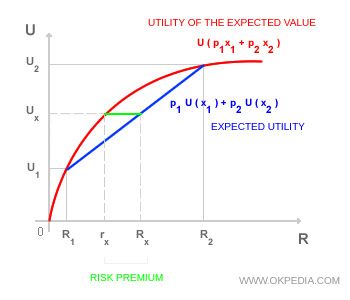Risk Aversion
Risk aversion refers to an individual’s attitude toward risk. A risk-averse person assigns greater value to the utility of a lottery’s expected outcome than to its expected utility. In other words, given a lottery (a random variable) with two possible outcomes X1 and X2, occurring with probabilities p1 and p2 respectively, the concept of risk aversion can be formalized as follows:

On the left-hand side of the inequality is the utility of the expected value of the lottery; on the right-hand side is the lottery’s expected utility. A risk-averse individual would rather receive the expected monetary value for certain than be exposed to the uncertainty of the lottery, even if both yield the same average return. Graphically, risk aversion can be illustrated on a Cartesian plane as follows:

The graph shows the utility of the expected value (in red) and the expected utility (in blue). The same level of utility, Ux, can be achieved with a guaranteed payoff rx, which is lower than the lottery’s expected payoff Rx. The difference between Rx and rx represents the risk premium - the amount the individual is willing to forgo to avoid uncertainty.
 Corollary. An individual is risk-averse if the expected value of a lottery exceeds its certainty equivalent. If the two are equal, the individual is said to be risk-neutral.
Corollary. An individual is risk-averse if the expected value of a lottery exceeds its certainty equivalent. If the two are equal, the individual is said to be risk-neutral.
 Risk aversion stems from an innate tendency to avoid potential harm or financial loss caused by adverse events - whether due to one’s own actions, others’ behavior, or sheer chance. It is a psychological trait shared by most people. Exceptions include those who actively seek out risk and display little or no aversion - in fact, they often prefer uncertain outcomes. Barring these rare cases, every individual exhibits some degree of risk aversion, which varies from person to person. Because this trait is subjective and psychological in nature, each person’s risk tolerance is uniquely their own. In general, risk aversion tends to decline as personal wealth increases. This is because the marginal utility of wealth diminishes as one becomes richer. In practical terms, someone with a net worth of 10 million euros values €100 far less than someone with no savings. This psychological "discounting" of monetary value weakens the natural aversion to risk. In short, as wealth grows, individuals typically become less risk-averse.
Risk aversion stems from an innate tendency to avoid potential harm or financial loss caused by adverse events - whether due to one’s own actions, others’ behavior, or sheer chance. It is a psychological trait shared by most people. Exceptions include those who actively seek out risk and display little or no aversion - in fact, they often prefer uncertain outcomes. Barring these rare cases, every individual exhibits some degree of risk aversion, which varies from person to person. Because this trait is subjective and psychological in nature, each person’s risk tolerance is uniquely their own. In general, risk aversion tends to decline as personal wealth increases. This is because the marginal utility of wealth diminishes as one becomes richer. In practical terms, someone with a net worth of 10 million euros values €100 far less than someone with no savings. This psychological "discounting" of monetary value weakens the natural aversion to risk. In short, as wealth grows, individuals typically become less risk-averse.
